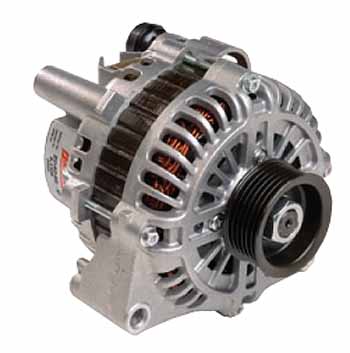 Replacing your alternator
Replacing your alternator
If your battery on your vehicle is constantly going dead forcing you to have to jump start your vehicle, it is likely that you have an alternator that is not working correctly.
The alternator on your vehicle provides voltage to your vehicle. This voltage is created and used by your vehicle and the accessories in your vehicle. The alternator produces more voltage than your vehicle needs and the excess voltage is then stored in your vehicles battery. The battery will provide a supply of voltage to start the vehicle. If your alternator is not putting out as much voltage as it should be then it will not have any excess to charge your battery, thus causing you to have a dead battery when you go to start your vehicle.
I suggest that you review this Basic Electronics article before you go ahead and replace your alternator. A simple test that you can do is to test the voltage at your battery with your vehicle running. You should have something greater than 13.5 DC Volts, this shows that your alternator is providing enough voltage to charge the battery.
Once you have determined that you need to replace your alternator then you can move onto the next procedure that we will discuss.
The Procedure
- Park your vehicle where you can work on it.
- Disconnect the negative post on the battery. If you do not do this you can risk sparking a wrench and causing a lot of problems.
- Next relieve the pressure on the belt tensioner; allowing you to remove the belt. You will need a 3/8th ratchet or a socket. If you don’t have either, this ATD1380 106Piece Socket Set should contain what you need. I also recommend that you draw out how the belt routes around the pulleys to ease installation.
- With the belt out of the way you will need to remove the nut on the back of your alternator. This nut is holding a thick wire. Remove this nut and set it aside.
- Remove any other electrical connectors connected to your alternator.
- Look at your new alternator and see if it has the pulley connected to it or not. If it does not have the pulley then you are going to need to remove the nut holding the alternator pulley in place. I recommend using a 3/8″ drive impact wrench
- Once the nut is removed the pulley may come off. If it does not come off you may need a puller such as this KD 41600 Puller Kit to remove the pulley.
- Next locate what is holding your alternator in place. Generally it is two long bolts that are holding it down. You will need to remove the bolts holding it down. If anything else is in the way remove that.
- Remove the alternator from the bracket. This is sometimes tricky. It helps to use a soft faced hammer to tap on one side of the alternator or a pry bar to pry it up and out. If you don’t have either, this ATD4082 3pc Dead Blow Hammer and WMRW2025 Pry Bar Set will work.
- You are now ready to reinstall your new alternator.
- If you had to remove the old pulley at this time take your soft faced hammer and tap the pulley into place.
- Then install the nut on the pulley and torque it down.
- You can now place the new alternator back into place. You may need to use the soft faced hammer and the pry bar to get the alternator into place.
- Reinstall the bolts that are holding the alternator in place and torque them down.
- Reinstall anything that was removed in order to get the alternator out.
- Connect the electrical connectors and install the nut that holds the wire onto the alternator.
- Use your ratchet to relieve the pressure on the tensioner and reinstall the belt making sure that it is routed correctly. This is where the drawing that you did comes in handy.
- Reconnect the negative post on the battery.
Now test your new alternator and use a multimeter to make sure that your new alternator is working correctly. You just finished replacing your alternator in your vehicle.
A little tip if you have a belt that is squealing this may be due to improper routing, so you may want to try to locate some service information on how your belt for your vehicle is routed.
Written by: Cody Mammenga an NDSCS Student
Tags: alternator, ATD, Battery, belt, dead battery, Electrical, electronics, ing, ingersoll rand, kd, kdt, nut, ratchet, replacing alternator, replacing belt, Tools, wmrw, wrench
